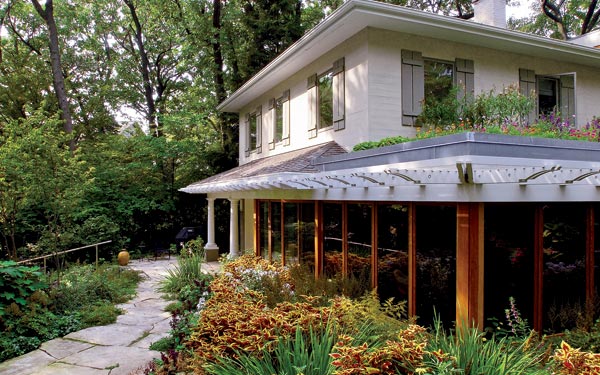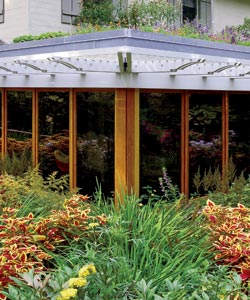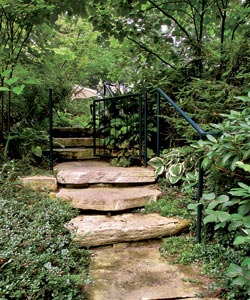
Stone paths lead up to the front door (bottom right) and around the property. The formerly white house was re-sided in gentle colors to fit in more harmoniously with the natural surroundings. Photo Gallery::: |
At first glance, it appears that in summer's floristic exuberance, this garden in Michigan City, Indiana, jumped its boundaries to colonize an empty roof and install a splash of beauty where shingles ought to be.
But what looks like a lucky accident was actually quite intentional. Instead of the monochromatic green sedums and grasses that have become standard on green roofs in the city, this garden, planted on the rooftop of an addition to a vacation home, is a festive mix of day lilies, phlox, perennial geraniums, astilbes, Solomon's seal, and some summer annuals. Many of those plants appear again in the ground-level landscape, further knitting together house and garden.
"We wanted to bring the landscape right up to the house and over the top of it, like a wave comes up onto a beach," says Douglas Hoerr. A landscape architect and principal of Hoerr Schaudt, he designed the garden in collaboration with David Woodhouse, the architect of the structural addition. "You're in a very natural setting there, with the undulating dunes shaping the landscape, and they were going to have to cut into it to build. So we thought we'd bring the undulation up onto the house."
Built in 1929 at the end of a cul-de-sac near Lake Michigan in Indiana's dunelands, the trim Colonial house had served as the present owners' getaway from Chicago for two decades. But with their extended family growing and their own retirement freeing them up to spend more days away from the city, they needed more space.
They looked at other houses, but ultimately couldn't stand to forsake the property they had enjoyed so long, with its pool set into a higher section of the dunes, far enough from the house to feel like a destination. So they would add on.
Through interior designer Mitchell Putlack, who had worked on the couple's Chicago home, they found Woodhouse, an architect admired for his ability to connect buildings intimately with their settings.
Woodhouse, in turn, brought Hoerr aboard early on, knowing the addition would require pushing the tree-covered dune back from its embrace of the house. Hoerr, a longtime Chicago landscape innovator (more than a decade ago, he turned then-new planters in the middle of Michigan Avenue into the riotously colorful summertime attraction they are now), would design some kind of rocky retaining walls to hold back the dune—but sensitively.

Landscape architect Douglas Hoerr collaborated on them with David Woodhouse, architect of the garden-topped addition. Photo Gallery::: |
"It was important to keep the integrity of the dunes," the homeowner says. That fragile landscape had delighted and welcomed them for so long, and they wanted to minimize the effects of cutting away a portion of the dune to make room for more house. The addition, they hoped, would demonstrate harmony with the landscape. Toward that end, the house, which had been stark white, would be re-sided in gentle, natural tones, and the new family room would have expansive windows to blur the line between indoors and out.
At some point, somebody noticed that the view from the pool would now be of asphalt roof instead of dune and house. "We didn't want to be looking at that when we've been looking at [nature] all these years," the homeowner says.
The project team agreed, and came up with the solution of a rooftop garden. Because the landscape architect was already on board—instead of being called in after construction —Hoerr and Woodhouse were able to plan ahead for a structure that could support the weight of plantings.
And that has made all the difference. Woodhouse used stone and wood for the addition to enhance its connection to nature. On the rooftop, Hoerr arranged the planting areas at different depths, so the gardens undulate slightly instead of lying pancake flat. But they weren't trying to pretend the house wasn't there. "It's a built extension of the dune," Hoerr says, not ersatz nature.
The finished product is "brilliant," the homeowner says. "Sitting and looking at the garden all around is one of life's pleasures."
Resources Design: Hoerr Schaudt Landscape Architecture, 312-492-6501; hoerrschaudt.com. Architect: David Woodhouse Architects, 312-943-3120; davidwoodhouse.com. Interior Design: Mitchell Putlack Interiors, 312-640-0600; mitchellputlack.com.
Photography: Linda Oyama Bryan
Related:



